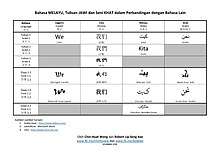Malaysian language
The Malaysian language (Malay: bahasa Malaysia, Jawi: بهاس مليسيا) or Malaysian Malay (Malay: bahasa Melayu Malaysia), is the name regularly applied to the Malay language used in Malaysia (as opposed to the lect used in Indonesia, which is referred to as the Indonesian language). Constitutionally, however, the official language of Malaysia is Malay, but the government from time to time refers to it as Malaysian. Standard Malaysian is a standard form of the Johore-Riau dialect of Malay. It is spoken by much of the Malaysian population, although most learn a vernacular form of Malay or other native language first.[1] Malay is a compulsory subject in primary and secondary schools.[4]
| Malaysian | |
|---|---|
| bahasa Malaysia بهاس مليسيا | |
| Pronunciation | [baˈhasə malajˈsiə] |
| Native to | Malaysia |
Native speakers | Spoken by the vast majority of those in Malaysia, although most learn a local Malay dialect or other native language first.[1] |
Austronesian
| |
| Latin (Rumi) Arabic (Jawi)[2] Malaysian Braille | |
Signed forms | Bahasa Malaysia Kod Tangan |
| Official status | |
Official language in | |
| Regulated by | Dewan Bahasa dan Pustaka (Institute of Language and Literature) |
| Language codes | |
| ISO 639-3 | zsm |
| Glottolog | stan1306[3] |
Status
Article 152 of the Federation designates Malay as the official language. Between 1986 and 2007, the official term Bahasa Malaysia was replaced by "Bahasa Melayu". Today, to recognize that Malaysia is composed of many ethnic groups (and not only the ethnic Malays), the term Bahasa Malaysia has once again become the government's preferred designation for the Bahasa Kebangsaan (National Language) and the Bahasa Perpaduan/Penyatu (unifying language/lingua franca).[5] Moreover, the language is also referred to as BM or simply Bahasa.[6] English continues, however, to be widely used in professional and commercial fields and in the superior courts.
Writing system


The script of the Malaysian language is prescribed by law as the Latin alphabet, known in Malay as Rumi (Roman alphabets), provided that the Arabic alphabet called Jawi (or Malay script) is not proscribed for that purpose. Rumi is official while efforts are currently being undertaken to preserve Jawi script and to revive its use in Malaysia.[7][8][9] The Latin alphabet, however, is still the most commonly used script in Malaysia, both for official and informal purposes.
Borrowed words
The Malaysian language has most of its borrowings absorbed from Sanskrit, Tamil, Hindi, Persian, Portuguese, Dutch, Sinitic languages, Arabic and more recently, English (in particular many scientific and technological terms). Modern Malaysian Malay has also been influenced lexically by the Indonesian variety, largely through the popularity of Indonesian dramas, soap operas, and music.[10]
Colloquial and contemporary usage
Colloquial and contemporary usage of Malay includes modern Malaysian vocabulary, which may not be familiar to the older generation, such as awek (girl), balak (guy) or cun (pretty). New plural pronouns have also been formed out of the original pronouns and the word orang (person), such as kitorang (kita + orang, the exclusive "we", in place of kami) or diorang (dia + orang, "they"). Code-switching between English and Malaysian and the use of novel loanwords is widespread, forming Bahasa Rojak. Consequently, this phenomenon has raised the displeasure of linguistic purists in Malaysia, in their effort to uphold use of the prescribed standard language.
See also
- Differences between the Malaysian and Indonesian languages
- Indonesian language
- Jawi, an Arabic script based writing system for Malay
- Language politics
- Malaysian English, English language used formally in Malaysia.
- Varieties of Malay
References
- Malaysian at Ethnologue (18th ed., 2015)
- "Kedah MB defends use of Jawi on signboards". The Star. 26 August 2008. Archived from the original on 29 October 2012.
- Hammarström, Harald; Forkel, Robert; Haspelmath, Martin, eds. (2017). "Standard Malay". Glottolog 3.0. Jena, Germany: Max Planck Institute for the Science of Human History.
- Ministry of Education: Frequently Asked Questions — To uphold Bahasa Malaysia and to strengthen the English language (MBMMBI) Archived 11 September 2014 at the Wayback Machine; access date 3 November 2013
- Wai, Wong Chun; Edwards, Audrey (4 June 2007). "Back to Bahasa Malaysia". The Star Online.
- Penggunaan Istilah Bahasa Malaysia Dan Bukan Bahasa Melayu Muktamad, Kata Zainuddin. BERNAMA, 5 November 2007
- "Malay". www.baystateinterpreters.com. Retrieved 26 June 2019.
- December 2014, Published 4 years ago on 18. "Use of Jawi should be encouraged, not condemned — Faidhur Rahman Abdul Hadi and Fatihah Jamhari | Malay Mail". www.malaymail.com. Retrieved 26 June 2019.
- "Khat to be included in school curriculum". The Star. Petaling Jaya. 30 July 2019. Retrieved 13 August 2019.
- Sneddon, James N. (2003). The Indonesian Language: Its history and role in modern society. UNSW Press.
External links
| Malay edition of Wikipedia, the free encyclopedia |
| For a list of words relating to Malaysian language, see the Malaysian language category of words in Wiktionary, the free dictionary. |
- Dewan Bahasa dan Pustaka (Institute of Language and Literature Malaysia, in Malay only)
- Malay Online Web Application with 40 Interactive Free Lessons
- Malay–English Online Dictionary (from Malay to English only) from Webster's Dictionary
- Malay–English Online Dictionary
- The Malay Spelling Reform, Asmah Haji Omar, (Journal of the Simplified Spelling Society, 1989-2 pp. 9–13 later designated J11)
- Pogadaev, V.A., Rott, N. V. Kamus Bahasa Russia – Bahasa Malaysia. Lebih kurang 30 000 perkataan. Moscow: Russky Yazik, 1986